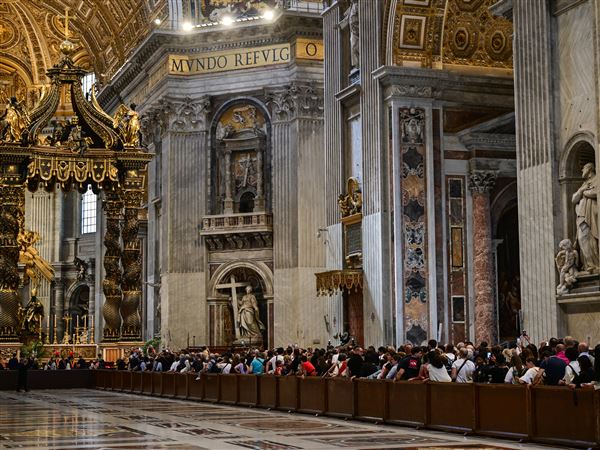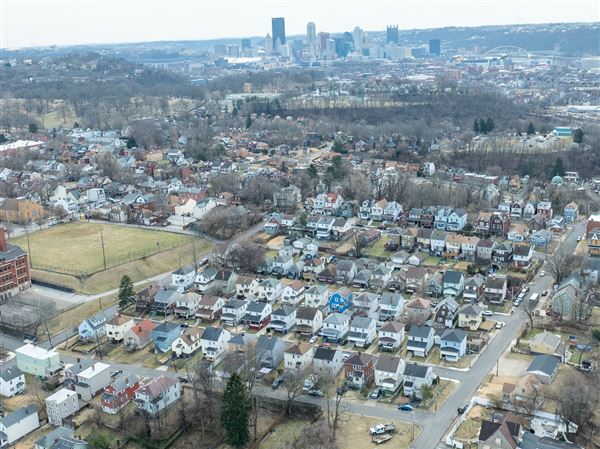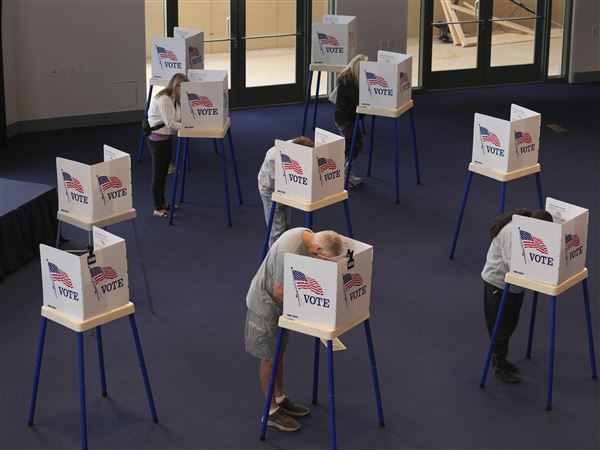
Photos by Darrell Sapp, Post-Gazette
The "Persians" as lily pads in the Victoria Room's pool, which reflects more "Persians" in the chandelier above.
By Patricia Lowry, Pittsburgh Post-Gazette
Surrounded by plants of ancient lineage, Thomas Gray lifts up the long electric drill that he's using to bore holes in the elevated soil of the Fern Room at Phipps Conservatory and Botanical Gardens.
"Can I get two stakes, please, and a hammer?" he says to the crew below.
Gray taps the stakes partially into the earth, then slips over them long, hollow glass spears that, once in place, metamorphose into impossibly thin red reeds. Dozens have shot up among the plants in the Fern Room, which, like most of the Victorian conservatory, is being transformed into a garden of contemporary glass.
"Chihuly at Phipps: Gardens & Glass," which opens to the public on Thursday, is spectacular in the best sense of the word, with dazzling, daring displays of brilliantly colored, intricately patterned and sensuously shaped glass.
Gray is one of 101 people who work for Dale Chihuly, the undisputed king of the glass art world, a man whose drive, vision, charisma and multimillion-dollar glass empire have helped make Seattle the glass art capital of the world. The school he founded with two patrons 50 miles north of Seattle in 1971 -- Pilchuck Glass School -- and his own hot shop have trained glass artists who have stayed in the region and started their own shops, creating an industry that employs more than 3,000 people, even more, Chihuly says, than Venice, Italy.
His output is prodigious, enabled by a teamwork approach not unlike Warhol's Factory and Tiffany Studios. At 65, Chihuly directs the work through drawings and verbal and visual cues but no longer physically makes it. That irks his critics, who wonder if all of the work he signs is actually his.
"It's just kind of hard for me," Chihuly said over the phone, "especially because of my left eye," which was blinded in a car accident in England in 1976. He lacks peripheral and stereo vision, "and we move around fast out there. And I quite enjoy the role that I play, which is kind of like a film director. Once in a while, I'll blow glass just for the fun of it."
It's kind of a moot point; he could never blow enough glass these days to meet the demand. Over four decades, Chihuly's work has evolved from small studio pieces to architectural installations on a grand scale, such as a pedestrian bridge in his native Tacoma and a glass ceiling in the lobby of the Bellagio Hotel and Casino in Las Vegas, featuring hundreds of pieces in his "Persians" series, which can take on the shape of a petunia or lily pad. If the latter seems too crassly commercial a commission, here's another way to look at it: Chihuly, whose vessels, prints, drawings, books and videos are for sale at the resort, is bringing beauty and enlightenment to the masses. Who better to convert than people with obvious disposable income?
And his work, no matter who makes it, is all about the beauty. It's also about pushing himself and his crews to make aesthetic and technical breakthroughs that allow him to go where no glass artist has gone before.
Blanket approach
In the 1970s he and a few collaborators began experimenting with thin glass threads, creating "drawings" that could be fused onto a three-dimensional glass form. It was Chihuly who fully developed the idea, creating his "Navajo Blanket Cylinders," inspired by blankets he saw in a museum. (He now owns a group of Navaho blankets, one of many collections that make his Seattle waterfront live-work space, featured in this month's Metropolitan Home magazine, a sort of single-family museum.)
And it was Chihuly who began slumping glass in 1977 in his "Baskets" series, letting the hot molten material do what comes naturally.
"The slumping of the baskets, I think I can get credit for that. There aren't a whole lot of things that I developed that I can say were my ideas," Chihuly said. "In 2,000 years of glassblowing, they didn't leave a lot uncovered."
But since the early 1990s, his work has taken on a dramatically different and unprecedented scale. He has suspended sculptures he calls chandeliers over the sidewalks and canals of Venice and installed glass towers in Jerusalem's ancient Citadel of David. He has permanent installations under way in new buildings in Abu Dhabi, Dubai, Macau and Las Vegas.
All of this work seems to more truly reflect his education -- a bachelor's degree in interior design and a master's in sculpture -- than the studio pieces for which he became known.

A chandelier composed of works from Chihuly's "Persians" series hangs in the Victoria Room
Click photo for larger image.
 Phipps has timed tickets for Chihuly show
Phipps has timed tickets for Chihuly show Carnegie goes Venetian; Glass Center has first international exhibition
Carnegie goes Venetian; Glass Center has first international exhibition
 Chihuly at Phipps: Gardens & Glass
Chihuly at Phipps: Gardens & Glass
Hear glass artist Dale Chihuly talking about his life and work:
 On the moment in 1965, in a basement in Seattle, when he knew he wanted to work in glass
On the moment in 1965, in a basement in Seattle, when he knew he wanted to work in glass
 On the trip to Israel in 1963 that changed his life
On the trip to Israel in 1963 that changed his life
 On how he hopes people will respond to his Phipps exhibit
On how he hopes people will respond to his Phipps exhibit

Large glass balls from Chihuly's "Niijima floats" series fill a boat in a newly created pond in the South Conservancy.
Click photo for larger image.

Chihuly's "Macchia" vessels came about when he wanted to create a series using every color in his hot shop.
Click photo for larger image.
And then there are the conservatories: seven collaborations in seven years. The first came in 2001 at the Garfield Park Conservatory in Chicago, followed by installations in public gardens and conservatories in Columbus, Ohio; Atlanta; Coral Gables, Fla.; London; New York; and St. Louis, where it drew 950,000 visitors.
"The minute I walked into Garfield Park Conservatory I said, 'This is gorgeous. We have to bring it to Pittsburgh.' And we've been working on it ever since," said Richard Piacentini, Phipps executive director.
In turn, the "Chihuly at Phipps" project sparked this year's city-wide celebration of glass.
Both Piacentini and Phipps staff exhibit designer Michele McCann visited Seattle, where Chihuly's people created mock-ups of the dimensions of each Phipps room in a large warehouse to work out the designs. The finished sculptures and room-sized installations were disassembled, packed into foam-pellet-filled cartons and shipped to Pittsburgh on five tractor-trailer beds.
Piacentini wouldn't reveal how much Phipps is paying Chihuly Inc. for the temporary exhibit, citing a confidentiality agreement. But he expects it will attract 150,000 new visitors, and that many visitors will come to see it twice, in the day and at night, when it's dramatically illuminated.
"At night it's a different show," Piacentini said. "The beauty of a lot of the glass is in the way it reflects light."
For his part, Chihuly is pleased to be working in a conservatory that features seasonal displays along with its permanent plant collection. "It wasn't so overfilled with vegetation," Chihuly said. With the Spring Flower Show removed, "We could put a piece or installation in the greenhouse and still see the building glass [the walls and roof of the conservatory] around it. It was a little more sparse than most greenhouses, and that really made it better for us in terms of having a show."
Glass gardens
Marrying Chihuly's glass with conservatories and gardens is a natural union; much of his work has been inspired by the plant world, which he first experienced as a child in his mother's garden, where rhododendrons, azaleas, hydrangeas and roses grew. Chihuly enjoyed a close relationship with his mother until her death last year at 98. His father, a butcher and union organizer, died at 51 of a heart attack in 1958, a year after Chihuly's brother and only sibling was killed during a Naval Air Force training accident. Last year, Chihuly married his second wife, Leslie Jackson, with whom he has an 8-year-old son.
Since the car accident, Chihuly has worn a black eye patch that, along with his woolly hair and boldly colored clothing, lends him the romantic air of a risk-taking adventurer, which he certainly is. He may be the head of one of the planet's most successful art businesses, but Chihuly dresses like a child in bright, saturated, primary colors: a red or royal blue shirt, say, over custom-made neon yellow pants. It's not an affectation. It's who he is, a man in touch with his inner 5-year-old, one who still draws with squeeze bottles of paint and signs his name really big on the page.
"I never met a color I didn't like" is one of the more famous Chihulyisms.
One of his best-known series, the "Macchia" (mock-ee-ah) vessels, began one day in 1981 when he woke up wanting to use all 300 colors in the hot shop. He made a color chart showing one color on the interior, another on the exterior and a third, contrasting color on the edge, or "lip wrap." More layers of color were added during the blowing process, creating a wildly variegated surface. The name "Macchia" came about when Chihuly asked his friend Italo Scanga what the Italian word is for "spotted."
The "Macchia" are shown to great effect on metals stands in Phipps' Sunken Garden room, where they seem to rise up out of bold, fan-like Licuala palms whose stiff, prominent ribs and ruffled edges are a foil for the smooth, undulating glass.
For the Phipps show, Chihuly's installers worked with McCann, the exhibit designer, and Phipps director of horticulture Karen Daubmann to select the plants. Their primary mandate was to use plants with form and texture but no colorful flowers or foliage; Chihuly's glass would provide the color.
His "Ikebana" series -- glass flowers spilling out of tall glass vases -- began after a trip to Japan and is featured in Phipps' Orchid Room. Chihuly has traveled widely and taken his teams to work in glass factories in Finland, France, Ireland and Mexico, where the native glassblowers used to working with molds have been blown away by the freedom of expression and form in Chihuly's glass.
While much of the work at Phipps represents reconfigurations of thousands of individual blown-glass components previously installed at other gardens, there is also much that is new, made in Chihuly's waterfront Seattle studio and in Finland. The center of the South Conservatory, home to the garden railroad, has been gutted and redesigned as a naturalistic water garden, with a pool, waterfalls and a boat -- a frequent Chihuly motif, but for the first time holding the large glass balls he calls Niijima floats. Growing up near the Pacific, Chihuly has an enduring affection for the sea and its living things, another influence on the work.
Chihuly, who visited Phipps early in the planning but will see the exhibit in person for the first time just before the opening, entrusted the aesthetics and logistics of the installation to two longtime employees, Parks Anderson and Tom Lind, who update him regularly.
Whose work is it?
Chihuly's delegating of tasks to employees caused the Seattle Times to take a critical look at his methods last year after he sued a former employee and an entrepreneur for copyright infringement over their production of work similar to his, and they countersued. They settled out of court, but not before the Times questioned who is the true author of the work: Chihuly or his glassblowers, especially when the work continues during his absences.
"I've had a lot of input from different gaffers, as we call them, but hardly ever have I had them give me an idea for something new that I wanted to do," he said. "They've had input on my ideas, not so much new ideas. Partly that's because a lot of them work for themselves" and save their inspiration for their own work.
Chihuly says the production of his work will end when he does.
But he has found a way to make the glassblower's art live large, and as with Warhol's and Tiffany's work, it will find a way to live on.
In the meantime, "Chihuly at Phipps" runs through Nov. 11. Catch it while you can.

Click photo for larger image.
First Published: May 4, 2007, 8:45 p.m.














